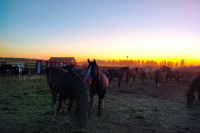Fingers still crossed
Status of the Lake Junaluska eagles remains a mystery, but I still have my fingers crossed for a successful nesting venture. There was some disturbance near the nest a week or so ago — tree trimming on adjacent property — and for a day or two it seemed the eagles were MIA.
The woodcock — secretive, rotund and acrobatic
While walking stream banks or low-lying wetlands, you have perhaps had the memorable experience of flushing a woodcock — that secretive, rotund, popeyed, little bird with an exceedingly long down-pointing bill that explodes from underfoot and zigzags away on whistling wings and just barely managing bat-like to dodge tree limbs and trunks.
The Naturalist's Corner: Birds in the hand
The Hilton Pond Center for Piedmont Natural History in York, South Carolina, is one of the few year round banding stations in the region.
The eagles have landed
The eagles’ neighbors have known for months, observant birders and other Lake Junaluska regulars have either known or suspected, and I have sat on the news for a while as I consulted with North Carolina Wildlife Resources Commission (NCWRC) and U.S. Fish & Wildlife, but those two beautiful, large brown raptors with the white heads and tails that have been patrolling the lake regularly for the past few months are, indeed, Lake Junaluska residents.
The Naturalist's Corner: Will eagles dare?
A pair of mature bald eagles has been hanging out at Lake Junaluska for a few months now. I have heard two separate reports of these birds carrying nesting material. In the dark musty cobweb covered labyrinth that serves as my memory, I seem to remember reading about bald eagles nesting on Waterville (Walters) Lake, along the Pigeon River in northwest Haywood County near the Tennessee border back in the late 1970s. However, I recently did a Google search and could find no reference, so? Maybe some reader(s) could clear that up for me?
Christmastime for birders: Cold weather can’t cool enthusiasm for Christmas Bird Count
At 8 a.m. on a December morning, the newly risen sun had barely warmed the air over Franklin from the previous night’s low of 18 degrees when knots of bundled-up birders began gathering across the county to partake in a chilly winter tradition — the Christmas Bird Count.
One of those knots formed at the Big Bear entrance to the Little Tennessee River Greenway, a crew of four birders — plus one Smoky Mountain News reporter — waiting in frosty low-30s weather to receive their marching orders.
The Naturalist's Corner: A long time coming
Some time around mid-September I added tic number 207 to my 2017 bird list. It was a merlin I saw one afternoon along the Blue Ridge Parkway while I was watching migrating broad-winged hawks. Then — nothing; nothing for a long time.
Blue jays arouse mixed feelings among humans
Everyone knows what a blue jay looks and sounds like in a general sort of way. Their incandescent blue plumage and raucous “thief! thief! thief!” calls are a vibrant part of everyday life. It is a stunningly beautiful bird with a bag full of attitudes and postures.
A wall can’t stop these migrants
Regrettably a wall through desert and riparian lowlands along the Mexico-U.S. border will have terrible effects on terrestrial fauna whose home range includes both sides of an imaginary line in the sand. However other migrants will, likely, never notice a wall unless, of course, it is lit up like an airport landing strip.
The Naturalist's Corner: That’s a wrap
Another spring, another season of bird points in the can. Each spring brings its own unique set of adventures, dilemmas and logistical challenges.













